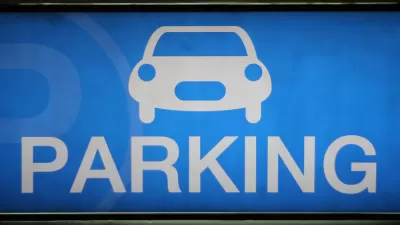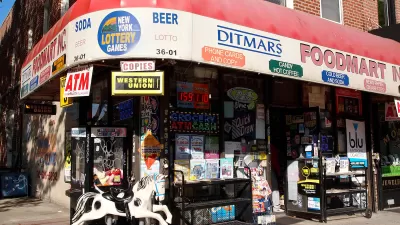Historic planning documents, like those found in the APA's Planning Advisory Service, are full of lessons about how past planning doctrines failed their intentions, and it's always a good time for planners to re-evaluate their antecedents.
Chuck Marohn responds to a January 1954 report detailing site design, parking, and zoning recommendations for shopping centers. (The American Planning Association released the report to honor of the history of their Planning Advisory Service, which has offered planning expertise since 1949.)
"Understanding this was the beginning of the heyday of relevance and influence of the planning profession -- a 15 to 20 year period that ended with the failures of urban renewal, the natural trajectory of this intellectual mentality -- it's fascinating to read the logic employed here," writes Marohn.
So along those lines there's some good news and there's some bad news. To start with the bad news, the report prioritizes parking over the value of the land. To quote from the report:
The shopper wants a space he can find easily, with a minimum of difficulty in moving around the parking area, and one that is located near the store or store group in which he is going to shop. The fault is sometimes with the developers who have underestimated the need for parking space or found the land too valuable to be devoted to parking.
As for the good news, Marohn also notes that the report shares some valuable insight that has been lost over the years, like how parking requirements shouldn't be one-size-fits-all. Also to quote from the report:
..there will be more walk-in business in a neighborhood shopping center than in a community or regional shopping center, and therefore the smaller center will not require proportionately as much off-street parking space as the large center.
Hat tip to Angie Schmitt at Streetsblog USA for sharing news of Marohn's post.
FULL STORY: CAN YOU HAVE TOO MUCH PARKING?

Study: Maui’s Plan to Convert Vacation Rentals to Long-Term Housing Could Cause Nearly $1 Billion Economic Loss
The plan would reduce visitor accommodation by 25,% resulting in 1,900 jobs lost.

North Texas Transit Leaders Tout Benefits of TOD for Growing Region
At a summit focused on transit-oriented development, policymakers discussed how North Texas’ expanded light rail system can serve as a tool for economic growth.

Why Should We Subsidize Public Transportation?
Many public transit agencies face financial stress due to rising costs, declining fare revenue, and declining subsidies. Transit advocates must provide a strong business case for increasing public transit funding.

Dear Tesla Driver: “It’s not You, It’s Him.”
Amidst a booming bumper sticker industry, one writer offers solace to those asking, “Does this car make me look fascist?”

A Visual Celebration of Manhattan’s Chinatown Elder Community, Through Food
Lanterns, cafeteria trays, and community connection take center stage in this stunning photo essay.

How to Make US Trains Faster
Changes to boarding platforms and a switch to electric trains could improve U.S. passenger rail service without the added cost of high-speed rail.
Urban Design for Planners 1: Software Tools
This six-course series explores essential urban design concepts using open source software and equips planners with the tools they need to participate fully in the urban design process.
Planning for Universal Design
Learn the tools for implementing Universal Design in planning regulations.
City of Santa Clarita
Ascent Environmental
Institute for Housing and Urban Development Studies (IHS)
City of Grandview
Harvard GSD Executive Education
Toledo-Lucas County Plan Commissions
Salt Lake City
NYU Wagner Graduate School of Public Service





























